Abstract
Malignant hyperthermia (MH) is a potentially lethal pharmacogenetic disease for which MH susceptibility (MHS) is transmitted as an autosomal dominant trait. A potentially life-threatening MH crisis is triggered by exposure to commonly used inhalational anesthetics and depolarizing muscle relaxants. The first malignant hyperthermia susceptibility locus (MHS1) was identified on human chromosome 19q13.1, and evidence has been obtained that defects in the gene for the calcium-release channel of skeletal muscle sarcoplasmic reticulum (ryanodine receptor; RYR1) can cause some forms of MH. However, MH has been shown to be genetically heterogeneous, and additional loci on chromosomes 17q and 7q have been suggested. In a collaborative search of the human genome with polymorphic microsatellite markers, we now found linkage of the MHS phenotype, as assessed by the European in vitro contracture test protocol, to markers defining a 1-cM interval on chromosome 3q13.1. A maximum multipoint lod score of 3.22 was obtained in a single German pedigree with classical MH, and none of the other pedigrees investigated in this study showed linkage to this region. Linkage to both MHS1/RYR1 and putative loci on chromosome 17q and 7q were excluded. This study supports the view that considerable genetic heterogeneity exists in MH.
Full text
PDF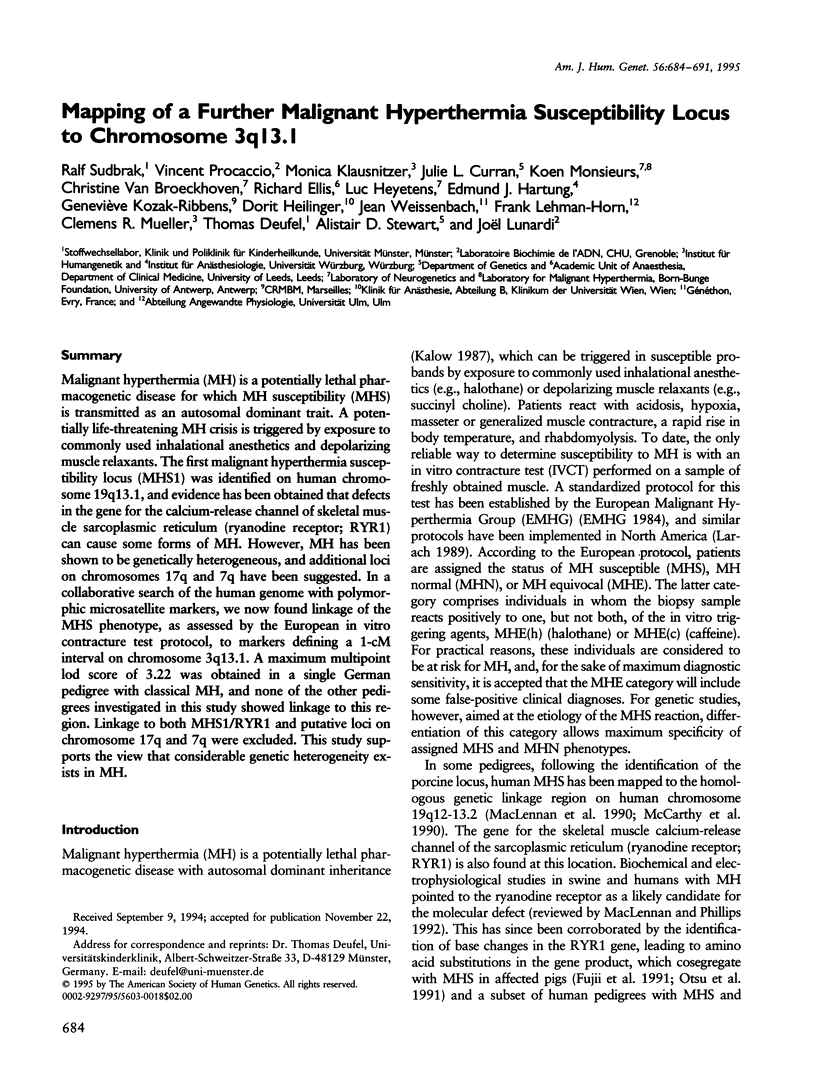
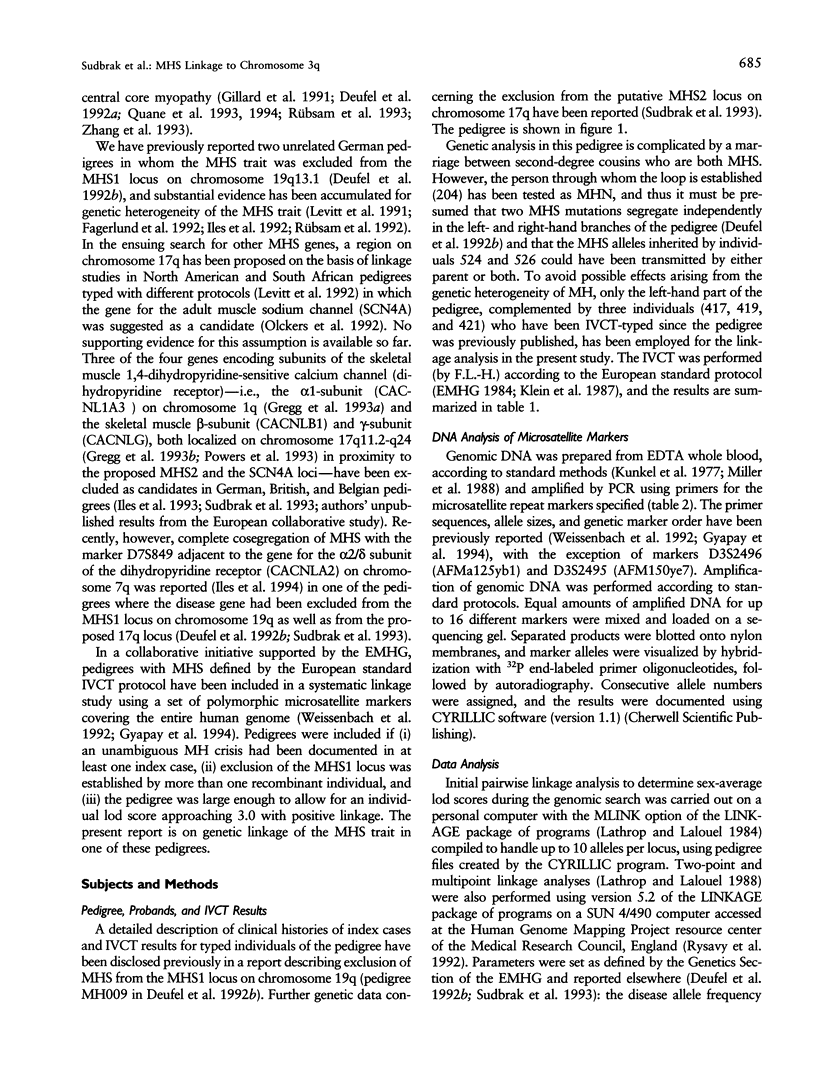
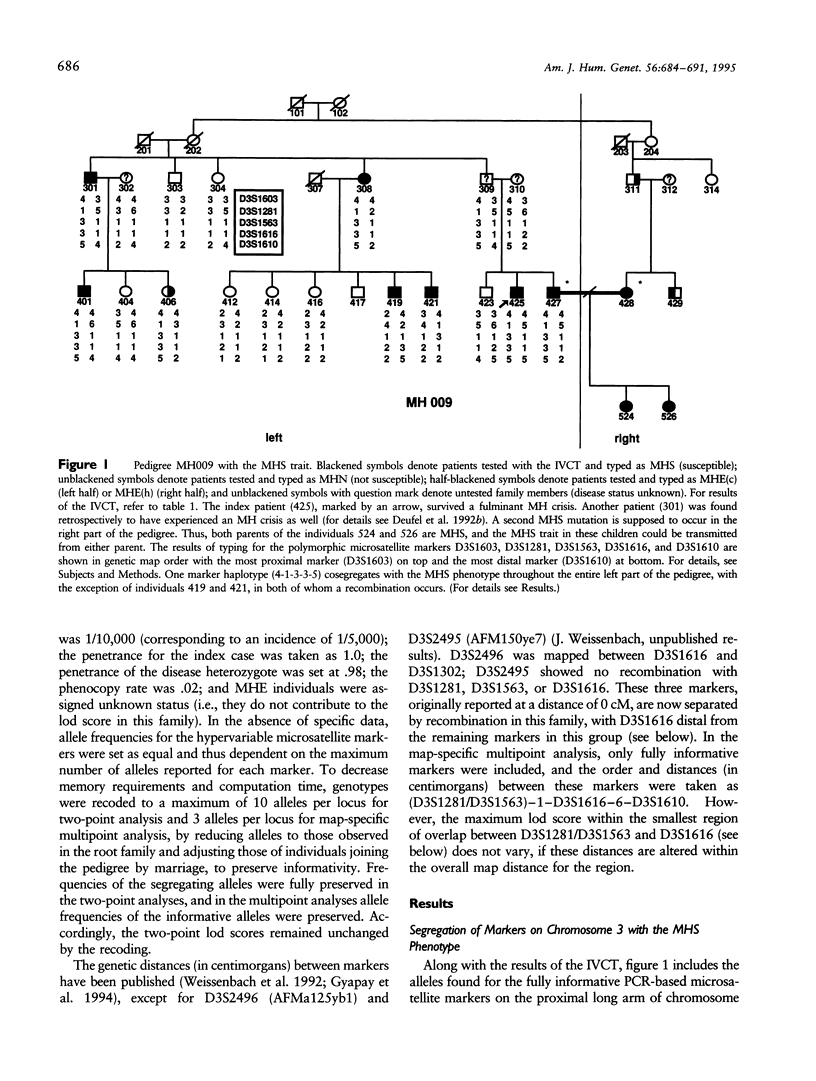
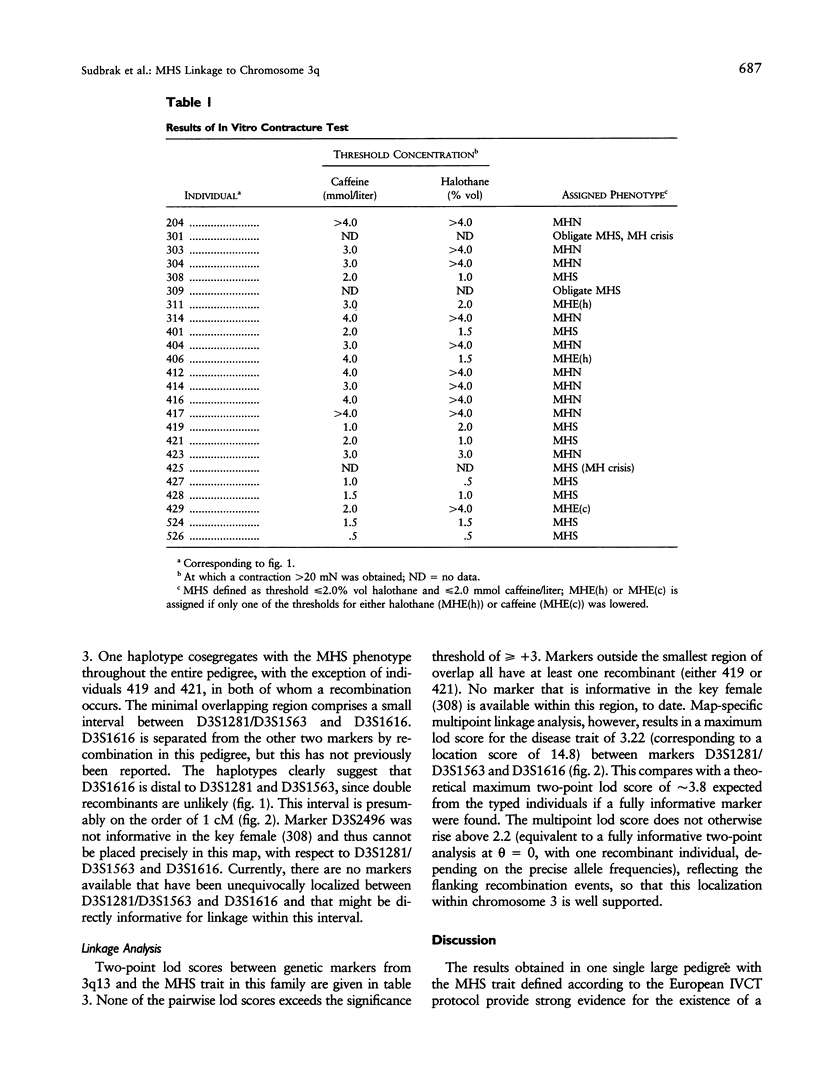
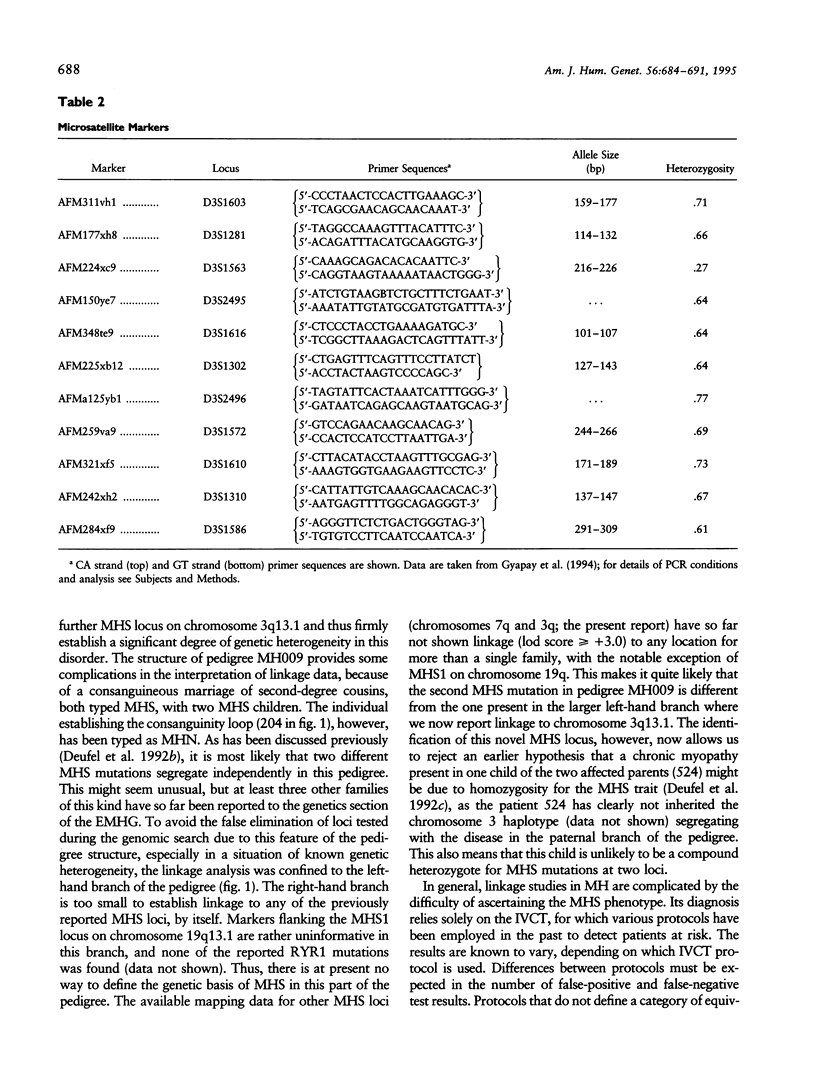
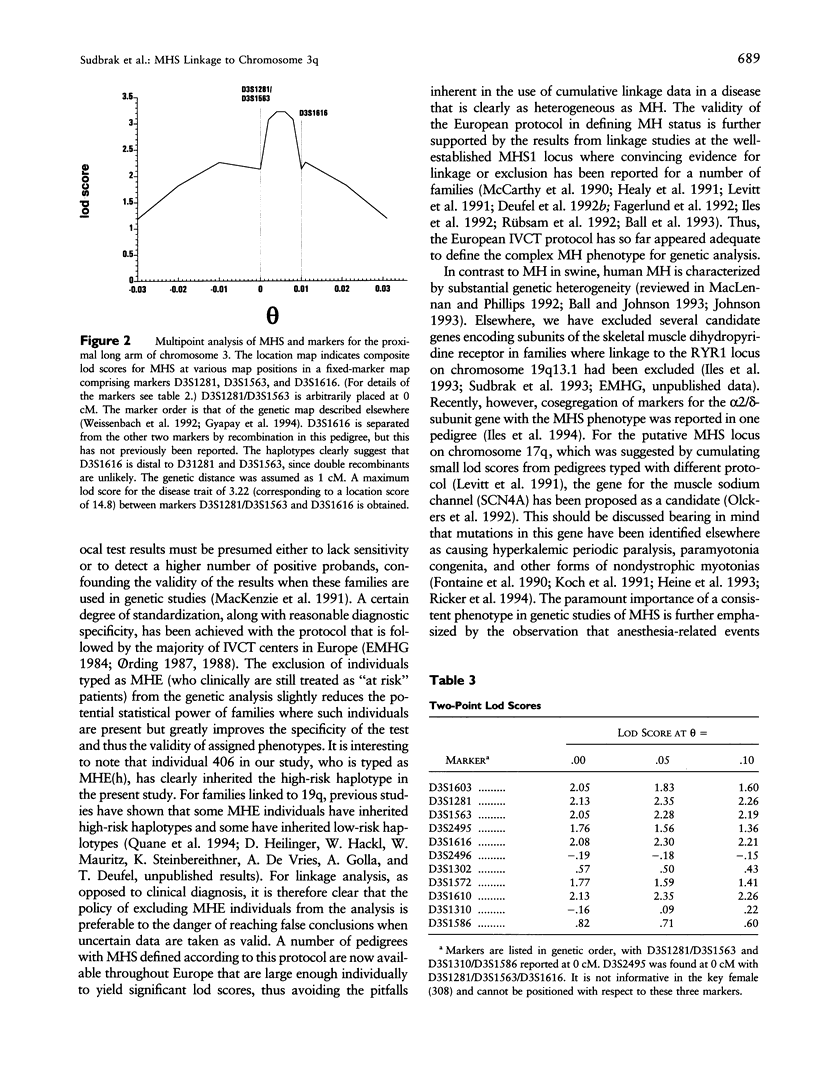
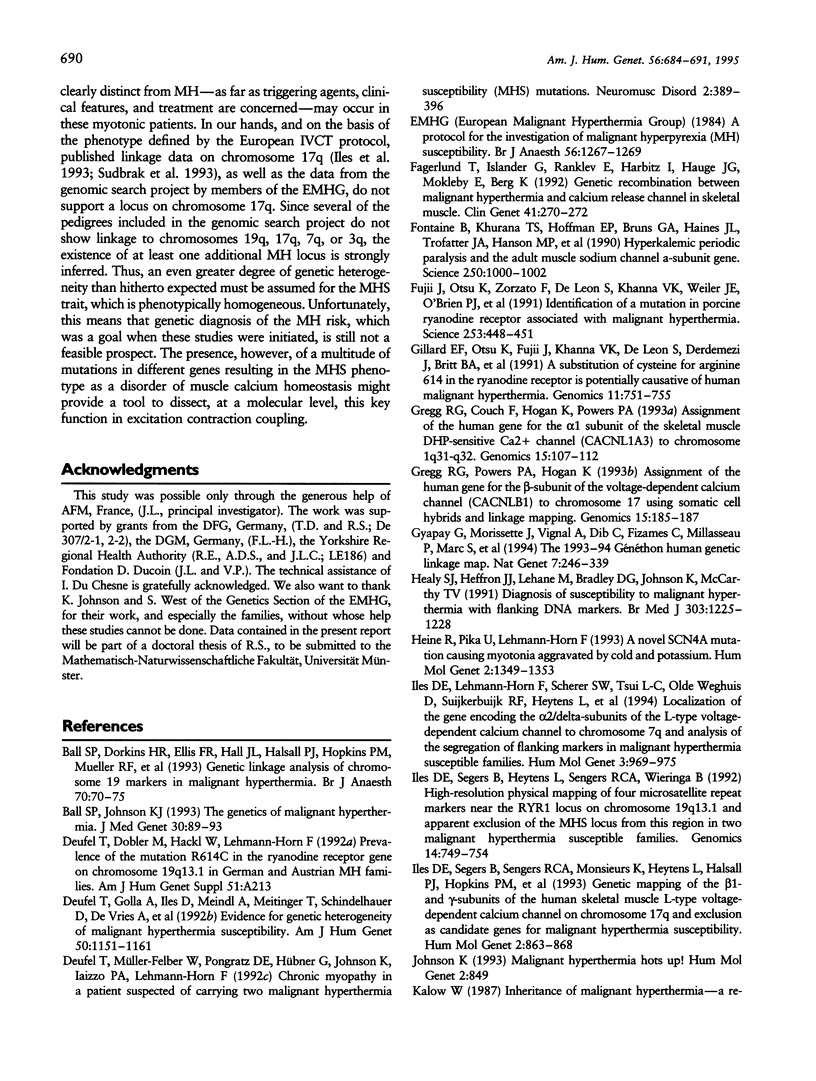
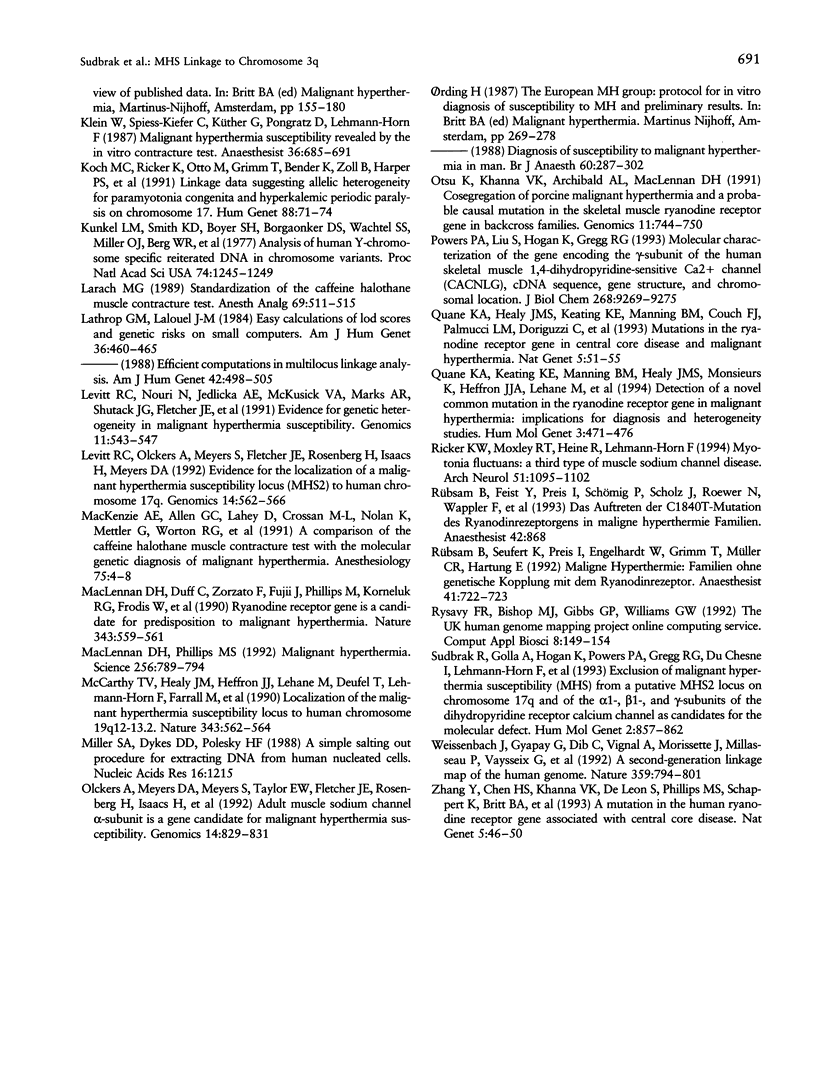
Selected References
These references are in PubMed. This may not be the complete list of references from this article.
- Ball S. P., Dorkins H. R., Ellis F. R., Hall J. L., Halsall P. J., Hopkins P. M., Mueller R. F., Stewart A. D. Genetic linkage analysis of chromosome 19 markers in malignant hyperthermia. Br J Anaesth. 1993 Jan;70(1):70–75. doi: 10.1093/bja/70.1.70. [DOI] [PubMed] [Google Scholar]
- Ball S. P., Johnson K. J. The genetics of malignant hyperthermia. J Med Genet. 1993 Feb;30(2):89–93. doi: 10.1136/jmg.30.2.89. [DOI] [PMC free article] [PubMed] [Google Scholar]
- Deufel T., Golla A., Iles D., Meindl A., Meitinger T., Schindelhauer D., DeVries A., Pongratz D., MacLennan D. H., Johnson K. J. Evidence for genetic heterogeneity of malignant hyperthermia susceptibility. Am J Hum Genet. 1992 Jun;50(6):1151–1161. [PMC free article] [PubMed] [Google Scholar]
- Deufel T., Müller-Felber W., Pongratz D. E., Hübner G., Johnson K., Iaizzo P. A., Lehmann-Horn F. Chronic myopathy in a patient suspected of carrying two malignant hyperthermia susceptibility (MHS) mutations. Neuromuscul Disord. 1992;2(5-6):389–396. doi: 10.1016/s0960-8966(06)80010-6. [DOI] [PubMed] [Google Scholar]
- Fagerlund T., Islander G., Ranklev E., Harbitz I., Hauge J. G., Møkleby E., Berg K. Genetic recombination between malignant hyperthermia and calcium release channel in skeletal muscle. Clin Genet. 1992 May;41(5):270–272. [PubMed] [Google Scholar]
- Fontaine B., Khurana T. S., Hoffman E. P., Bruns G. A., Haines J. L., Trofatter J. A., Hanson M. P., Rich J., McFarlane H., Yasek D. M. Hyperkalemic periodic paralysis and the adult muscle sodium channel alpha-subunit gene. Science. 1990 Nov 16;250(4983):1000–1002. doi: 10.1126/science.2173143. [DOI] [PubMed] [Google Scholar]
- Fujii J., Otsu K., Zorzato F., de Leon S., Khanna V. K., Weiler J. E., O'Brien P. J., MacLennan D. H. Identification of a mutation in porcine ryanodine receptor associated with malignant hyperthermia. Science. 1991 Jul 26;253(5018):448–451. doi: 10.1126/science.1862346. [DOI] [PubMed] [Google Scholar]
- Gillard E. F., Otsu K., Fujii J., Khanna V. K., de Leon S., Derdemezi J., Britt B. A., Duff C. L., Worton R. G., MacLennan D. H. A substitution of cysteine for arginine 614 in the ryanodine receptor is potentially causative of human malignant hyperthermia. Genomics. 1991 Nov;11(3):751–755. doi: 10.1016/0888-7543(91)90084-r. [DOI] [PubMed] [Google Scholar]
- Gregg R. G., Couch F., Hogan K., Powers P. A. Assignment of the human gene for the alpha 1 subunit of the skeletal muscle DHP-sensitive Ca2+ channel (CACNL1A3) to chromosome 1q31-q32. Genomics. 1993 Jan;15(1):107–112. doi: 10.1006/geno.1993.1017. [DOI] [PubMed] [Google Scholar]
- Gregg R. G., Powers P. A., Hogan K. Assignment of the human gene for the beta subunit of the voltage-dependent calcium channel (CACNLB1) to chromosome 17 using somatic cell hybrids and linkage mapping. Genomics. 1993 Jan;15(1):185–187. doi: 10.1006/geno.1993.1029. [DOI] [PubMed] [Google Scholar]
- Gyapay G., Morissette J., Vignal A., Dib C., Fizames C., Millasseau P., Marc S., Bernardi G., Lathrop M., Weissenbach J. The 1993-94 Généthon human genetic linkage map. Nat Genet. 1994 Jun;7(2 Spec No):246–339. doi: 10.1038/ng0694supp-246. [DOI] [PubMed] [Google Scholar]
- Healy S. J., Heffron J. J., Lehane M., Bradley D. G., Johnson K., McCarthy T. V. Diagnosis of susceptibility to malignant hyperthermia with flanking DNA markers. BMJ. 1991 Nov 16;303(6812):1225–1228. doi: 10.1136/bmj.303.6812.1225. [DOI] [PMC free article] [PubMed] [Google Scholar]
- Heine R., Pika U., Lehmann-Horn F. A novel SCN4A mutation causing myotonia aggravated by cold and potassium. Hum Mol Genet. 1993 Sep;2(9):1349–1353. doi: 10.1093/hmg/2.9.1349. [DOI] [PubMed] [Google Scholar]
- Iles D. E., Lehmann-Horn F., Scherer S. W., Tsui L. C., Olde Weghuis D., Suijkerbuijk R. F., Heytens L., Mikala G., Schwartz A., Ellis F. R. Localization of the gene encoding the alpha 2/delta-subunits of the L-type voltage-dependent calcium channel to chromosome 7q and analysis of the segregation of flanking markers in malignant hyperthermia susceptible families. Hum Mol Genet. 1994 Jun;3(6):969–975. doi: 10.1093/hmg/3.6.969. [DOI] [PubMed] [Google Scholar]
- Iles D. E., Segers B., Heytens L., Sengers R. C., Wieringa B. High-resolution physical mapping of four microsatellite repeat markers near the RYR1 locus on chromosome 19q13.1 and apparent exclusion of the MHS locus from this region in two malignant hyperthermia susceptible families. Genomics. 1992 Nov;14(3):749–754. doi: 10.1016/s0888-7543(05)80179-x. [DOI] [PubMed] [Google Scholar]
- Iles D. E., Segers B., Sengers R. C., Monsieurs K., Heytens L., Halsall P. J., Hopkins P. M., Ellis F. R., Hall-Curran J. L., Stewart A. D. Genetic mapping of the beta 1- and gamma-subunits of the human skeletal muscle L-type voltage-dependent calcium channel on chromosome 17q and exclusion as candidate genes for malignant hyperthermia susceptibility. Hum Mol Genet. 1993 Jul;2(7):863–868. doi: 10.1093/hmg/2.7.863. [DOI] [PubMed] [Google Scholar]
- Johnson K. Malignant hyperthermia hots up! Hum Mol Genet. 1993 Jul;2(7):849–849. doi: 10.1093/hmg/2.7.849. [DOI] [PubMed] [Google Scholar]
- Klein W., Spiess-Kiefer C., Küther G., Pongratz D., Lehmann-Horn F. Diagnose der Anlage zu Maligner Hyperthermie mit Hilfe des in vitro-Kontrakturtests. Anaesthesist. 1987 Dec;36(12):685–691. [PubMed] [Google Scholar]
- Koch M. C., Ricker K., Otto M., Grimm T., Bender K., Zoll B., Harper P. S., Lehmann-Horn F., Rüdel R., Hoffman E. P. Linkage data suggesting allelic heterogeneity for paramyotonia congenita and hyperkalemic periodic paralysis on chromosome 17. Hum Genet. 1991 Nov;88(1):71–74. doi: 10.1007/BF00204932. [DOI] [PubMed] [Google Scholar]
- Kunkel L. M., Smith K. D., Boyer S. H., Borgaonkar D. S., Wachtel S. S., Miller O. J., Breg W. R., Jones H. W., Jr, Rary J. M. Analysis of human Y-chromosome-specific reiterated DNA in chromosome variants. Proc Natl Acad Sci U S A. 1977 Mar;74(3):1245–1249. doi: 10.1073/pnas.74.3.1245. [DOI] [PMC free article] [PubMed] [Google Scholar]
- Larach M. G. Standardization of the caffeine halothane muscle contracture test. North American Malignant Hyperthermia Group. Anesth Analg. 1989 Oct;69(4):511–515. [PubMed] [Google Scholar]
- Lathrop G. M., Lalouel J. M. Easy calculations of lod scores and genetic risks on small computers. Am J Hum Genet. 1984 Mar;36(2):460–465. [PMC free article] [PubMed] [Google Scholar]
- Levitt R. C., Nouri N., Jedlicka A. E., McKusick V. A., Marks A. R., Shutack J. G., Fletcher J. E., Rosenberg H., Meyers D. A. Evidence for genetic heterogeneity in malignant hyperthermia susceptibility. Genomics. 1991 Nov;11(3):543–547. doi: 10.1016/0888-7543(91)90061-i. [DOI] [PubMed] [Google Scholar]
- Levitt R. C., Olckers A., Meyers S., Fletcher J. E., Rosenberg H., Isaacs H., Meyers D. A. Evidence for the localization of a malignant hyperthermia susceptibility locus (MHS2) to human chromosome 17q. Genomics. 1992 Nov;14(3):562–566. doi: 10.1016/s0888-7543(05)80152-1. [DOI] [PubMed] [Google Scholar]
- MacKenzie A. E., Allen G., Lahey D., Crossan M. L., Nolan K., Mettler G., Worton R. G., MacLennan D. H., Korneluk R. A comparison of the caffeine halothane muscle contracture test with the molecular genetic diagnosis of malignant hyperthermia. Anesthesiology. 1991 Jul;75(1):4–8. doi: 10.1097/00000542-199107000-00002. [DOI] [PubMed] [Google Scholar]
- MacLennan D. H., Duff C., Zorzato F., Fujii J., Phillips M., Korneluk R. G., Frodis W., Britt B. A., Worton R. G. Ryanodine receptor gene is a candidate for predisposition to malignant hyperthermia. Nature. 1990 Feb 8;343(6258):559–561. doi: 10.1038/343559a0. [DOI] [PubMed] [Google Scholar]
- MacLennan D. H., Phillips M. S. Malignant hyperthermia. Science. 1992 May 8;256(5058):789–794. doi: 10.1126/science.1589759. [DOI] [PubMed] [Google Scholar]
- McCarthy T. V., Healy J. M., Heffron J. J., Lehane M., Deufel T., Lehmann-Horn F., Farrall M., Johnson K. Localization of the malignant hyperthermia susceptibility locus to human chromosome 19q12-13.2. Nature. 1990 Feb 8;343(6258):562–564. doi: 10.1038/343562a0. [DOI] [PubMed] [Google Scholar]
- Miller S. A., Dykes D. D., Polesky H. F. A simple salting out procedure for extracting DNA from human nucleated cells. Nucleic Acids Res. 1988 Feb 11;16(3):1215–1215. doi: 10.1093/nar/16.3.1215. [DOI] [PMC free article] [PubMed] [Google Scholar]
- Olckers A., Meyers D. A., Meyers S., Taylor E. W., Fletcher J. E., Rosenberg H., Isaacs H., Levitt R. C. Adult muscle sodium channel alpha-subunit is a gene candidate for malignant hyperthermia susceptibility. Genomics. 1992 Nov;14(3):829–831. doi: 10.1016/s0888-7543(05)80206-x. [DOI] [PubMed] [Google Scholar]
- Otsu K., Khanna V. K., Archibald A. L., MacLennan D. H. Cosegregation of porcine malignant hyperthermia and a probable causal mutation in the skeletal muscle ryanodine receptor gene in backcross families. Genomics. 1991 Nov;11(3):744–750. doi: 10.1016/0888-7543(91)90083-q. [DOI] [PubMed] [Google Scholar]
- Powers P. A., Liu S., Hogan K., Gregg R. G. Molecular characterization of the gene encoding the gamma subunit of the human skeletal muscle 1,4-dihydropyridine-sensitive Ca2+ channel (CACNLG), cDNA sequence, gene structure, and chromosomal location. J Biol Chem. 1993 May 5;268(13):9275–9279. [PubMed] [Google Scholar]
- Quane K. A., Healy J. M., Keating K. E., Manning B. M., Couch F. J., Palmucci L. M., Doriguzzi C., Fagerlund T. H., Berg K., Ording H. Mutations in the ryanodine receptor gene in central core disease and malignant hyperthermia. Nat Genet. 1993 Sep;5(1):51–55. doi: 10.1038/ng0993-51. [DOI] [PubMed] [Google Scholar]
- Quane K. A., Keating K. E., Manning B. M., Healy J. M., Monsieurs K., Heffron J. J., Lehane M., Heytens L., Krivosic-Horber R., Adnet P. Detection of a novel common mutation in the ryanodine receptor gene in malignant hyperthermia: implications for diagnosis and heterogeneity studies. Hum Mol Genet. 1994 Mar;3(3):471–476. doi: 10.1093/hmg/3.3.471. [DOI] [PubMed] [Google Scholar]
- Ricker K., Moxley R. T., 3rd, Heine R., Lehmann-Horn F. Myotonia fluctuans. A third type of muscle sodium channel disease. Arch Neurol. 1994 Nov;51(11):1095–1102. doi: 10.1001/archneur.1994.00540230033009. [DOI] [PubMed] [Google Scholar]
- Rysavy F. R., Bishop M. J., Gibbs G. P., Williams G. W. The UK Human Genome Mapping Project online computing service. Comput Appl Biosci. 1992 Apr;8(2):149–154. doi: 10.1093/bioinformatics/8.2.149. [DOI] [PubMed] [Google Scholar]
- Sudbrak R., Golla A., Hogan K., Powers P., Gregg R., Du Chesne I., Lehmann-Horn F., Deufel T. Exclusion of malignant hyperthermia susceptibility (MHS) from a putative MHS2 locus on chromosome 17q and of the alpha 1, beta 1, and gamma subunits of the dihydropyridine receptor calcium channel as candidates for the molecular defect. Hum Mol Genet. 1993 Jul;2(7):857–862. doi: 10.1093/hmg/2.7.857. [DOI] [PubMed] [Google Scholar]
- Weissenbach J., Gyapay G., Dib C., Vignal A., Morissette J., Millasseau P., Vaysseix G., Lathrop M. A second-generation linkage map of the human genome. Nature. 1992 Oct 29;359(6398):794–801. doi: 10.1038/359794a0. [DOI] [PubMed] [Google Scholar]
- Zhang Y., Chen H. S., Khanna V. K., De Leon S., Phillips M. S., Schappert K., Britt B. A., Browell A. K., MacLennan D. H. A mutation in the human ryanodine receptor gene associated with central core disease. Nat Genet. 1993 Sep;5(1):46–50. doi: 10.1038/ng0993-46. [DOI] [PubMed] [Google Scholar]


